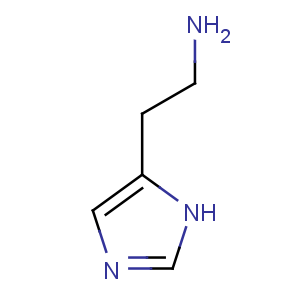Title: Histamine
CAS Registry Number: 51-45-6
CAS Name: 1
H-Imidazole-4-ethanamine
Synonyms: 2-(4-imidazolyl)ethylamine; 4-imidazoleethylamine; 5-imidazoleethylamine; b-aminoethylimidazole; b-aminoethylglyoxaline
Molecular Formula: C5H9N3
Molecular Weight: 111.15
Percent Composition: C 54.03%, H 8.16%, N 37.80%
Literature References: Biogenic amine widely distributed in nature; decarboxylation product of histidine,
q.v. Present in most mammalian tissues; primarily stored in mast cells and basophils. Exhibits multiple biological effects through at least 3 specific receptors. Induces bronchoconstriction and vasodilation; stimulates gastric acid secretion; and acts as a neurotransmitter. Synthesis: A. Windaus, W. Vogt,
Ber. 40, 3691 (1907); F. L. Pyman,
J. Chem. Soc. 101, 530 (1912). Identification as vasodilator: H. H. Dale, P. P. Laidlaw,
J. Physiol. 41, 318 (1910). Toxicity data: K. Nagai
et al., Arzneim.-Forsch. 17, 1575 (1967). Diagnostic use in pheochromocytoma: T. Nakai, R. Yamada,
J. Clin. Endocrinol. Metab. 57, 19 (1983); in airway responsiveness: A. James, G. Ryan,
Respirology 2, 97 (1997). Clinical efficacy in combination with interleukin-2,
q.v., in treatment of acute myelogenous leukemia: K. Hellstrand
et al., Leuk. Lymphoma 27, 429 (1997). Mechanism of antineoplastic activity:
eidem, Acta Oncol. 37, 347 (1998). Review of assay methods for determn in plasma: E. Oosting
et al., Clin. Exp. Allergy 20, 349-357 (1990). Review of role in allergic disease: M. V. White,
J. Allergy Clin. Immunol. 86, 599-605 (1990); in gastric acid secretion: K. J. Obrink,
Scand. J. Gastroenterol. 26, Suppl. 180, 4-8 (1991); in homeostatic energy metabolism: T. Sakata
et al., Nutrition 13, 403-411 (1997). Review of pharmacology and classification of receptors: S. J. Hill
et al., Pharmacol. Rev. 49, 253-278 (1997).
Properties: Deliquescent needles from chloroform, mp 83-84°. bp18 209-210°. Freely sol in water, alcohol, hot chloroform. Practically insol in ether. LD50 i.p. in mice: 2020 mg/kg (Nagai).
Melting point: mp 83-84°
Boiling point: bp18 209-210°
Toxicity data: LD50 i.p. in mice: 2020 mg/kg (Nagai)
Derivative Type: Dihydrochloride
CAS Registry Number: 56-92-8
Trademarks: Maxamine (Maxim)
Molecular Formula: C5H9N3.2HCl
Molecular Weight: 184.07
Percent Composition: C 32.63%, H 6.02%, N 22.83%, Cl 38.52%
Properties: Prisms from ethanol, mp 244-246°. Freely sol in water, methanol; sol in ethanol.
Melting point: mp 244-246°
Derivative Type: Phosphate
CAS Registry Number: 51-74-1
Molecular Formula: C5H9N3.2H3PO4
Molecular Weight: 307.14
Percent Composition: C 19.55%, H 4.92%, N 13.68%, P 20.17%, O 41.67%
Properties: Clear, colorless prisms from water, mp 132-133°. Readily sol in hot water.
Melting point: mp 132-133°
Therap-Cat: Antineoplastic (immunomodulator); diagnostic aid (gastric secretion, pheochromocytoma, bronchial hyperreactivity).
Keywords: Antiallergic (Hyposensitization Therapy); Diagnostic Aid.

